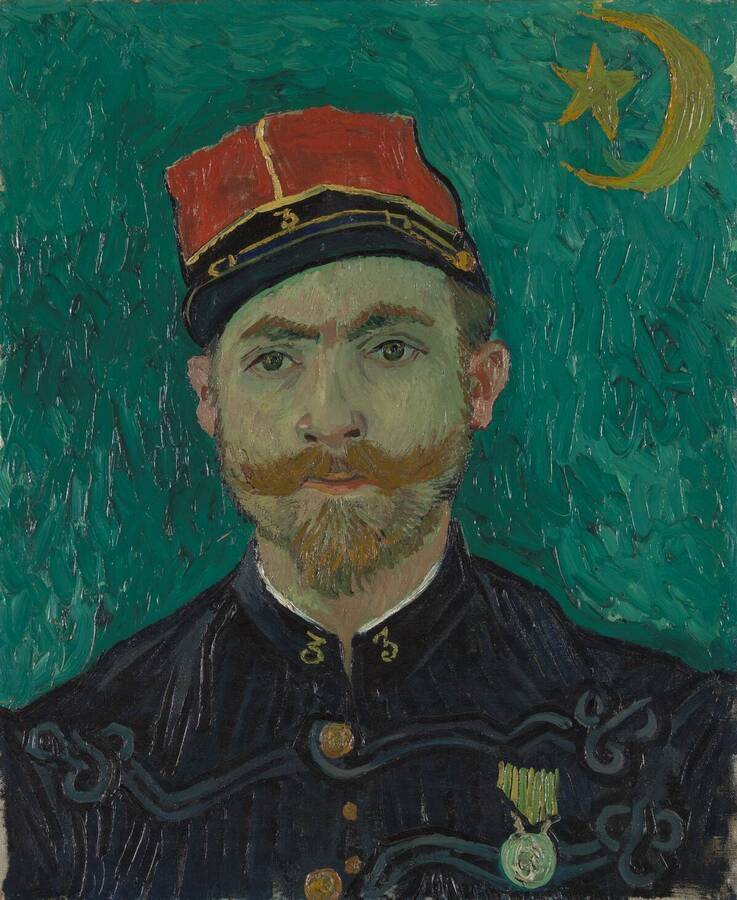 This portrait of Paul-Eugène Milliet was purchased by Helene Kröller-Müller in 1912. It is one of four portraits in the collection of the Kröller-Müller Museum that Van Gogh painted in the town of Arles in the South of France. The portrait is very popular, whether shown in the museum or abroad. Even in Helene’s day, the painting travelled extensively.
This portrait of Paul-Eugène Milliet was purchased by Helene Kröller-Müller in 1912. It is one of four portraits in the collection of the Kröller-Müller Museum that Van Gogh painted in the town of Arles in the South of France. The portrait is very popular, whether shown in the museum or abroad. Even in Helene’s day, the painting travelled extensively.
The lover (portrait of Lieutenant Milliet)
Paul-Eugène Milliet was a second lieutenant in the third Zouave regiment of the French army. He served in Tonkin (North Vietnam) and was repatriated to Arles in February 1888. There, he came into contact with Vincent van Gogh around June 1888. The two became good friends and regularly went out together. Van Gogh took Milliet along on his painting trips and gave him drawing lessons.
Painting Milliet's portrait did not initially go smoothly. In a letter to his brother Theo, Van Gogh writes: ‘[…] he poses badly, or else it’s my fault, which I don’t believe, however, because I badly need some studies of him because he’s good-looking, very jaunty, very easy-going in his appearance, and he’d suit me down to the ground for a painting of lovers. I’ve already promised him a study for his trouble, but there you are, he can’t keep still.’
The portrait shows Milliet in uniform. The medal for his service in Tonkin adorns his chest, while the symbol of his regiment is painted in the top right of the canvas: the crescent moon and star. There is little evidence of his restless posing in the painting. Milliet’s head is skilfully depicted and he stares out of the picture resolutely.
 Condition of the painting
Condition of the painting
Van Gogh painted Milliet in oil on a linen canvas. The painting has probably received treatment several times in the past. It has a wax-resin lining and is varnished. A wax-resin lining consisted of an additional canvas attached to the back of the painting with a mixture of melted wax and resin. This method was used in the past to reinforce the original canvas.
Structurally the painting is in good condition. There are no adhesion problems between the lining and the original canvas and the tension of the canvas on the stretcher is stable. The paint adhesion is also good, apart from a few small raised flakes of paint.
However, the previous treatments have left their mark. There are quite a lot of yellow wax-resin residues on the paint layer as a result of the lining and because loose paint was fixed using wax in the past. This gives an unsightly shiny, greasy effect.
As Van Gogh intended
The conservation will return Lieutenant Milliet to the way that Van Gogh intended. By removing the extremely shiny and yellowed varnish and the many yellow wax-resin residues from the paint surface, the painting is expected to regain its original colouration, matte surface and appearance. The texture of Van Gogh’s brushstrokes will also be more visible again. The most noticeable effect of this is likely to be in the dark blue coat, where most of the wax-resin residues are located. The old damage in the paint layer will be repaired.
The labour-intensive conservation will take place in two stages because the painting is on display in the exhibition Van Gogh at Palazzo Bonaparte in Rome from October 2022 to early May 2023. Painting conservator Madeleine Bisschoff will work on it for 800 hours in total, which amounts to more than five months full-time.
The total cost is budgeted at € 55,000. The conservation is made possible thanks to the support of Van Lanschot Kempen.
![]()
